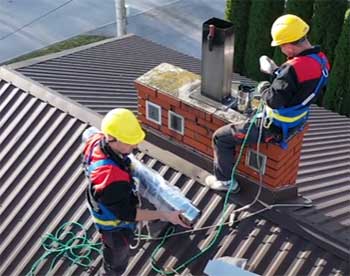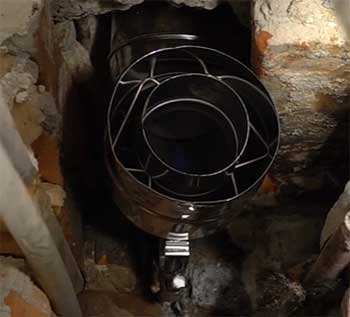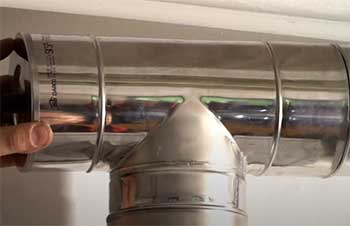Having a double-flue chimney can provide some great benefits, like allowing you to vent two different fireplaces or appliances through one chimney stack. However, it can also come with some frustrating smoke issues if not properly designed and maintained.
As someone who has dealt with my fair share of smoky chimneys, I definitely understand how unpleasant and concerning it can be when smoke starts pouring out into the room instead of up the chimney.
In this article, we’ll cover the most common double-flue chimney smoke issues homeowners face and how to troubleshoot them. Whether you’ve just started getting smoke in places it shouldn’t be or have been putting up with the problem for years, we’ll explore the likely culprits and solutions to get your system working cleanly again.
Problems With Double-Flue Chimney Smoke
Here is a list of its common issues:
- Smoke Crossover Between Flues
- Smoke Coming Into The Room
- Odors or Smoke Smell Throughout The House
- Smoky Fireplace Smell Lingering
- Smoky Smell When It’s Windy
Let’s explain those problems in detail and later, we will find some solutions.
Smoke Crossover Between Flues
One of the most common and irritating double-flue chimney problems is when smoke from one flue crosses over and comes down the other flue. This can happen for a few different reasons:
- Improper Flue Size

If one flue is a lot larger than the other, the pressure differences can cause smoke to get sucked into the weaker draft of the smaller flue.
Make sure both flues are sized appropriately for the fireplaces/appliances they serve.
- Wind Effects
Strong winds or gusts can also overpower the draft of one flue and push smoke across to the other one.
Adding chimney caps or relocating flue outlets higher up may help.
- Negative Pressure
Something like an attic fan, whole house fan, or furnace can put a room into negative pressure, which pulls air down the chimney instead of up, taking smoke along with it. Turn off these appliances when using your fireplaces.
- Improper Chimney Construction
If the flues were not properly separated during construction, smoke can easily transfer between channels. This may require re-lining the chimney to correct.
- Burning Practices
Trying to damper down one fireplace while another is burning well can make its flue too weak to withstand pressure from the stronger draft, pushing smoke across. Avoid burning both flues simultaneously.
Smoke Coming Into The Room
Another common and very annoying double (or single) flue issue is when smoke comes pouring out into the room instead of going up the chimney. Some potential reasons for this issue include:
- Blocked Chimney

Buildup of creosote or debris like bird nests, leaves, etc can partially or fully block the flue, preventing smoke from rising out.
A chimney sweep can clear the obstruction.
- Cold Chimney
If the chimney is cold when you first light a fire, the smoke can be dense and heavy until the flue warms up.
Starting with paper and kindling allows it to heat gradually.
- Strong Wind Gusts
Wind gusts can temporarily overpower the draft and force smoke out into the room. Consider an anti-down draft chimney cap to promote updraft.
- Negative Pressure
As mentioned before, any appliances or fans that actively pull air out of the home can contribute to negative pressure that sucks smoke into the room.
- Chimney Too Short/Improperly Sized
A chimney that is too short or narrow to properly draft all the smoke and exhaust up and out can cause backflow into the room. Adding chimney height or a larger flue liner may help.
- Creosote Buildup
Thick, restrictive creosote deposits make it hard for smoke to exit the chimney. A thorough chimney cleaning from a professional can remove these combustible deposits.
Odors or Smoke Smell Throughout The House
If you notice the smell of smoke throughout your home, even away from the fireplace, this is a sign that smoke is escaping the chimney and entering your living space. Potential causes include:
- Leaking Chimney Flue
The flue liner or chimney may have cracks, holes, failing joints, rust, etc that allow smoke to leak into the home. Replacement or re-lining will be needed.
- Missing or Defective Rain Cap
A chimney without a rain cap can allow moisture, smoke, animals, leaves, etc to enter. Cap inspection and replacement helps.
- Chimney Offsets/Bends
Offsets in the chimney can make it hard for smoke to rise directly up, allowing it to escape into the house. Adding fans or re-routing can help.
- Attic Access Near Chimney
If the attic hatch or access is too close to the chimney, smoke can easily transfer. Seal off the access point.
- Negative Pressure
As we’ve noted, whole house fans, attic fans, furnaces, etc can pull air down the chimney letting smoke in.
Smoky Fireplace Smell Lingering
If your fireplace gives off a strong smoky smell even after the fire has been out for some time, a few things could be to blame:
- Insufficient Air Supply
A fire needs ample oxygen to burn cleanly and allow smoke to vent up the chimney. Ensure your fireplace has enough air intake.
- Wet Wood
Wet, unseasoned wood burns inefficiently and creates more smoke that gets left behind after fires. Allow wood to dry for 6-12 months before burning.
- Poor Draft
An improperly constructed chimney that doesn’t create enough draft allows smoke to spill into the house over time. A chimney inspection can determine if improvements are needed.
- Creosote Buildup
Thick creosote leaves smoky, unburned particles behind after a fire. A certified chimney sweep can clean your flue system.
- Clogged Chimney
Debris like dead birds and leaves can clog the chimney and prevent proper draft. Cleaning clears the way for better updraft.
- Air Leaks in Flue
Cracks, empty mortar joints or holes in the flue liner allow smoke to waft into surrounding wall cavities. Re-lining or sealing is needed.
Smoky Smell When It’s Windy
If foul-smelling smoke seems to spill into your house only when the wind picks up, it’s likely an issue with chimney draft and wind direction/intensity. Some things that can help include:
- Adding a Chimney Cap
Caps help prevent wind gusts from blowing down the chimney. Look for rotational caps that move to block wind.
- Checking for Blockages
Wind can exaggerate draft issues from creosote or debris blockage. A chimney sweep will ensure your flue is clear.
- Extending Chimney Height
Increasing chimney height improves drafting power to overcome wind effects. An additional 3-5 feet often helps significantly.
- Avoiding Wind Direction
Pay attention to the direction of smoke drift and avoid burning fires when strong winds from that direction are forecasted.
- Improving Air Supply
Ensuring ample air intake to your fireplace provides the robust draft needed to stand up to wind gusts.
- Sealing Attic Openings
Attic access doors near the chimney should be tightly sealed so wind gusts don’t enter and get drawn down the chimney.
Also Read: Comparison of DuraPlus And DuraTech Chimney Systems.
Troubleshooting Guide For Double-Flue Chimney
Here is a quick troubleshooting guide to help identify common double-flue chimney smoke issues:
Smoke Smell Throughout House:

- Check for leaks in chimney and flue liners
- Examine chimney cap condition
- Ensure attic hatches near chimney are sealed off
- Disable whole house fans when using fireplaces
Smoky Odor Lingering:
- Burn only seasoned wood
- Have chimney swept and inspected
- Check for adequate air supply to fireplace
Smoke Entering Room:
- Inspect for chimney blockages
- Let chimney warm up before closing damper
- Install chimney cap to prevent wind issues
- Ensure proper sizing of flue for fireplace
Smoke Crossover Between Flues:
- Avoid burning both flues at once
- Examine flue construction for needed separation
- Check flue sizes and add chimney caps
- Disable any whole house fans while burning
Hopefully this gives you a good overview of the likely culprits behind various double-flue chimney smoke scenarios. While smoke issues can be annoying and concerning, a thorough inspection and targeted troubleshooting steps will help get your system back to working order. Let the smoke rise up and out of the chimney cleanly so you can enjoy cozy, smoke-free fires.
Also Read: Comparison of DuraVent And Selkirk Chimney Systems.
Frequently Asked Questions (FAQ)
Yes, smoke can sometimes transfer between flues in a multi-flue chimney stack. Common causes are wind gusts, pressure imbalances, differences in flue temperatures, inadequate flue separation, or one flue being much smaller than the other. Solutions involve adding chimney caps, ensuring proper flue sizing and separation, avoiding burning in only one flue, and extending chimney height.
The main reasons for a dual-flue chimney are to independently vent multiple fireplaces or appliances, provide redundancy if one flue needs repair, accommodate additions over time, maintain aesthetic symmetry, or isolate dissimilar exhaust like wood smoke and gas fumes.
Tips to prevent a double sided fireplace from smoking include using seasoned wood, getting the chimney cleaned and inspected yearly, fully opening the damper before fires, installing a chimney cap, extending the chimney height if needed, avoiding oversized fires, ensuring adequate air intake, and using a fireplace fan. Also, only burn one side at a time.
Smoke drifting down an unused chimney flue can be caused by wind gusts blowing smoke over, pressure imbalances in the house, burning hot fires when other flues are restricted, inadequate separation between flue liners, improperly sized flues, or flue blockages forcing smoke to redirect.
Wrapping Up
Dealing with smoke issues in a multi-flue chimney system can certainly be frustrating. However, through proper troubleshooting and maintenance, these problems can be effectively remedied.
Key actions like getting annual chimney inspections, installing wind-resistant chimney caps, ensuring adequate flue separation, and avoiding burning in only one flue at a time can all help minimize pesky smoke transfer between chimneys.
With a bit of chimney cleaning and tuning, your fireplaces can once again provide cozy, smoke-free warmth. Thanks for reading and I hope you found this overview on identifying and solving double-flue chimney smoke problems helpful.
Stay warm!
